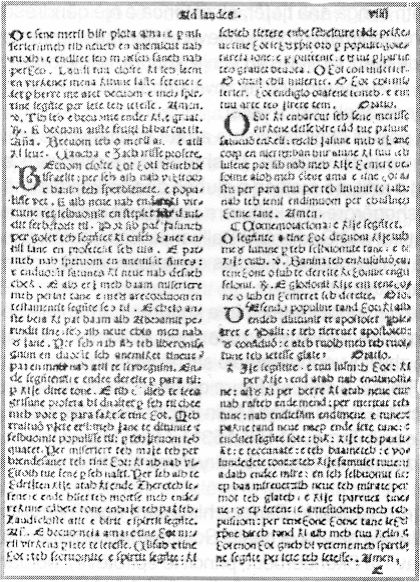
Teodor Shkodrani
:::::::::::::::::::::::::::::::::::::::::::::::::::::::::::::::::::::::::::::::::
The Ottoman Empire , which ruled Albania from the 15th to the early 20th century, prohibited publications in Albanian, an edict that became a serious obstacle to the development of literature in that language.The oldest example of writing in Albanian is a book-length manuscript on theology, philosophy, and history by Teodor Shkodrani that dates from 1210; it was discovered in the late 1990s in the Vatican archives.This document it ends with the phrase:
"Mee nihemmen zze dessimnee e phorte t'Lummummitt ZOT e mbaronjj v'Vitte
MCCX dittn ee IX t' Mmarxxitee."
THEODOR SSCODRAANNITTEE.
"With the help and the strong desire of holy GOD i finished it
in year 1210, the 9th day of March."
Teodor Shkodrani
Formula e Pagëzimit" (Baptesimal Formula)
::::::::::::::::::::::::::::::::::::::::::::::::::::::::::::::::::::::::::::::::
"Formula e Pagëzimit" (Baptesimal Formula), dating back to 1462, authored by Pal Engjëlli (or Paulus Angelus) (ca. 1417–1470), Archbishop of Durrës and a close friend and counselor of Skanderbeg. It was written in a pastoral letter for a synond at the Holy Trinity in Mat and read in Latin characters as follows, Unte paghesont premenit Atit et birit et spertit senit ("I baptize you in the name of the Father and the Son and the Holy Ghost"). It was discovered and published in 1915 by Nicolae Iorga.
Fjalori i Arnold von Harf ("Arnold von Harf vocabulary") 1469
::::::::::::::::::::::::::::::::::::::::::::::::::::::::::::::::::::::::::::::::
With the same Latin alphabet is written in 1497 the second document of the Albanian language,Arnold von Harf Vocabulary.The German traveler Arnold Fon Harf (1417-1505) left Cologne in 1496, to make a visit to the holy lands, in Palestine. In 1497 he arrived to the coast of Albania, and specifically in Ulcinj, Durres Sazan. During this trip he scored 26 Albanian words, 8 expression and numbers 1 to 10 and 100 and 1000 accompanied by translation into German. These words are common words such as: water, wine, bread, meat, etc..,Except the list of words, expressions and numerals; he has left also some notes describing the Albanian coastland. Among other things he writes that "the Albanian town Ulcinj is a beautiful small town. For the town of Shkodra, he says "it is a great city but occupied by the Ottomans.He describes the Sazan island "as a good sea port, with many ships, in the left wing of which is a large village with 2000 Hearth,called Vlore .
Ungjilli i Pashkëve ("Easter Gospel")
::::::::::::::::::::::::::::::::::::::::::::::::::::::::::::::::::::::::::::::
The third writen document of albanian language is Ungjilli i Pashkëve ("Easter Gospel")or Ungjilli i Shën Mateut ("Saint Matthew's Gospel")from the 15th century.
This document consists of 2 small parts from the Bible,written in Albanian and it was found in a Greek manuscript of the XIV century, with which they have no connection. They are in Southern dialect(Tosk), written with Greek letters. These facts show that the Albanian language in that time must have been written not only in Northern Albania, but also in South Albania.
The First Book
::::::::::::::::::::::::::::::::::::::::::::::::::::::::::::::::::::::::::::::::
The first book in Albanian was written by Gjon Buzuku between 20 March 1554 to 5 January 1555. In Albanian, the book is known as Meshari (The Missal). The book was written in the Gheg dialect in the Latin alphabet with some Slavic letters adapted for Albanian vowels. The book was discovered in 1740 by Gjon Nikollë Kazazi, the Albanian archbishop of Skopje. It contains the liturgies of the main holidays. There are also texts of prayers and rituals and catechetical texts. Every page contains two columns. The initials are decorated. The grammar and the vocabulary are more archaic than in the Gheg text from the 17th century. The text is very valuable from the viewpoint of the history of language. The 188 pages of the book comprise about 154,000 words with a total vocabulary of ca. 1,500 different words, and are a veritable precious source for lexicographers and historical linguists. The archaic text is easily read due to the circumstance that it is mainly a translation of known texts, in particular the Bible. Most of the Gospels of Matthew, Luke and John were translated in the book. It also contains passages from the Psalms, the Book of Isaiah, the Book of Jeremiah, the Letters to the Corinthians, and many illustrations. The consequent character of orthography and grammar seems to indicate an earlier tradition of writing. The Apostolic Library in the Vatican holds the only known copy of the book.




No comments:
Post a Comment